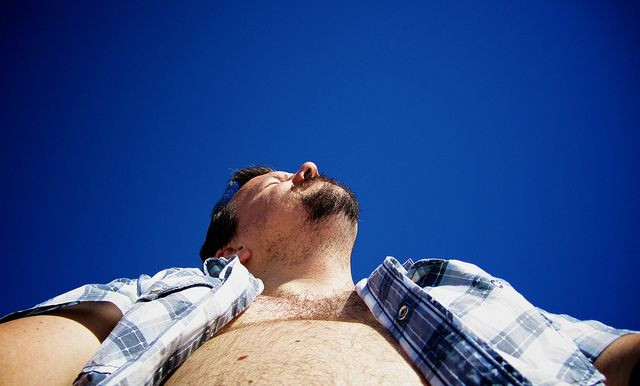Skin Cancer Is Mostly A Male Problem: Why Getting Guys To Wear Sunscreen Is So Difficult

On July 29, Surgeon General Dr. Boris Lushniak announced his growing concern of the country’s rising melanoma rates. We’re getting skin cancer, he warned, and a lot of it. But the cases aren’t created equal; men are significantly more likely to develop the illness than women, and it’s a trend that has persisted since 1975 in both incidence and death rates. How come?
Men, not to put too fine a point on it, are generally lousy when it comes to personal health. This isn’t commentary on responsibility, but rather an examination of the data. Being male already increases a person’s risk of smoking and drinking alcohol, being a heavy user of both substances, using illicit drugs, being obese, not following up on doctors’ visits, and not making preventive visits to the dentist. Should it be any wonder, then, that men are notoriously bad at the simple practice of putting on sunscreen?
“They’re not using it,” dermatologist Dr. Neal Schultz, also a spokesperson for The Skin Cancer Foundation, told New York Mag. “They’re not using enough. And then when things get rough and things start to happen … they’re clueless about the warning signs they should be looking for.”
As per Lushniak’s July announcement, melanomas are the most common form of cancer in the country. In 2010, the most recent year CDC data is available, 61,061 people were diagnosed with melanomas of the skin and 9,154 people died. Roughly 10,000 more men were diagnosed than women, and poor skin care is a major culprit.
The issue is partly biological. Even when scientists account for tumor location and size, they find men are 55 percent more likely to die from melanomas than women are. How they get those melanomas is where the heftier, more pervasive social aspects come in. First, the numbers are stacked against men, who are far more likely to hold jobs that require they work in the sun — long-haul truck drivers and construction workers, to name only a couple.
But even after taking those numbers into account, the gender issue heaps on an added layer of complexity. Soft, supple skin is feminine; tough, rugged skin is masculine. These divides feel natural, even if they imply a far darker outcome in terms of cancer risk. The problem is, applying a lotion of any kind is alien to most men, because the social custom neither dictates its necessity (women regularly apply makeup, and men don’t) nor rewards its application (skin care is historically feminine).
Basically, “guys don’t like applying schmear anywhere,” Schultz said, “but particularly to their face.”
This irrational fear of seeming wimpy is only reinforced by the fact married men, on average, live longer than single men. Presumably, it’s because single men don’t have a conscientious wife to pick up the pieces. A 2011 study of cardiovascular deaths, for instance, found married men were far more likely to seek preventive medical care than single men. Married women, however, didn’t echo this trend, signaling to the researchers something unique in the experience of being male.
All this speculation sits beside a flat out lack of awareness. When surveyed, 79 percent of men didn’t know, for instance, that the appropriate amount of sunblock to use is 1 ounce, and 61 percent believed the amount they do apply will last four hours, even though the Skin Cancer Foundation recommends people reapply every two hours. And in an even greater display of bad scientific know-how, nearly two-thirds of men believed women needed sunscreen more than they did because female skin was somehow more “sensitive” to ultraviolet rays.
“The survey results confirm what I see in my practice every day,” said Dr. Joshua Zeichner, a spokesperson for The Skin Cancer Foundation and Assistant Professor of Dermatology at Mount Sinai Medical Center. “Men just aren’t incorporating sun protection into their lives.”
Published by Medicaldaily.com



























